May 19, 2022 feature
Laser annealing transmon qubits for high-performance superconducting quantum processors
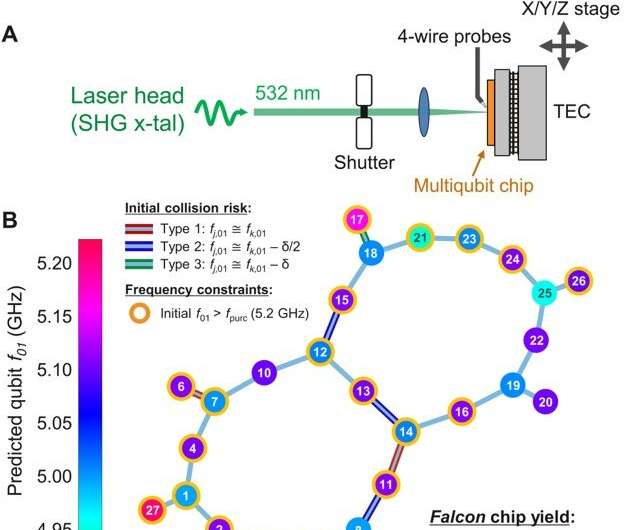
Quantum physicists aim to scale the number of qubits during quantum computing, while maintaining high-fidelity quantum gates; this is a challenging task due to the precise frequency requirements that accompany the process. Superconducting quantum processors with more than 50 qubits are currently actively available and these fixed frequency transmons are attractive due to their long coherence and noise immunity. A transmon is a type of a superconducting charge qubit designed to have reduced sensitivity to charge noise. In a new report now published in Science Advances, Eric J. Zhang and a team of scientists at IBM Quantum, IBM T.J. Watson Research Centre, New York, U.S., used laser annealing to selectively tune transmon qubits into the desired frequency patterns. The research team achieved a tuning precision of 18.5 MHz, without any measurable impact on quantum coherence, and envision facilitating selective annealing in this way to play a central role in fixed-frequency architectures.
Laser annealing of stochastically impaired qubits (LASIQ)
Multi-qubit systems can be built on superconducting circuit quantum electrodynamics architectures for a variety of applications, including implementing Shor's factoring algorithm, quantum chemistry simulations and machine learning. Researchers have also used the metric of quantum volume to track the continual progression of quantum processing power for a given processor. Quantum physicists had recently developed a technique for laser annealing of stochastically impaired qubits, abbreviated LASIQ to increase the collision-free yield of transmon lattices by tuning individual qubit frequencies via laser thermal annealing. In this work, Zhang et al demonstrated the LASIQ process as a scalable method to obtain the expected laser tuning precision. In addition to the number of tuned qubits, they measured the functional parameters of multi-qubit chips for high processor performance. During the study, they explored the LASIQ scaling capabilities by tuning a 65-qubit Hummingbird processor (accessible as ibmq_manhattan). Zhang et al. envision that the LASIQ process will be employed as a scalable frequency tuning tool for fixed frequency transmon architectures in future generations of superconducting quantum systems.
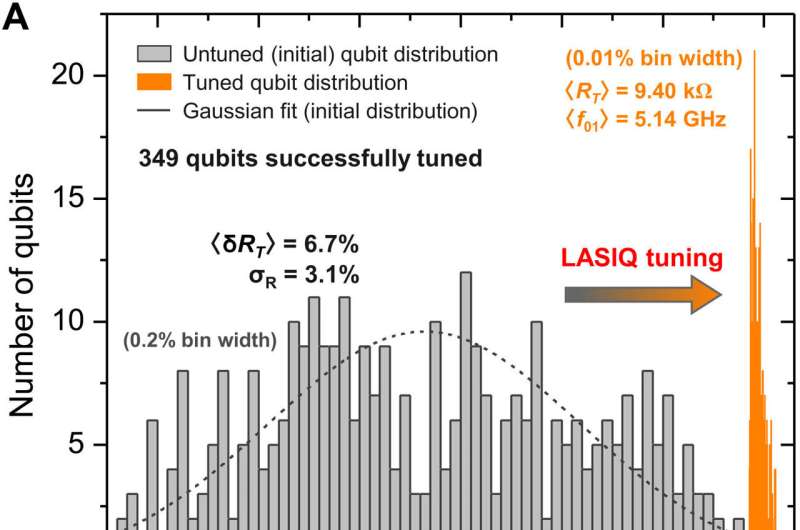
LASIQ tuning a 27-qubit Falcon processor and improving the tuning precision
As proof of concept, the team showed frequency tuning with a 27-qubit Falcon processor to predict frequency targets. They based the Falcon chip series on a heavy-hexagonal lattice and performed all measurements at ambient conditions to achieve tuned frequencies. The scientists evaded nearest neighbor collisions with twice the collision tolerance to improve chip yield against two-qubit state hybridization. In addition to avoiding collisions, the team tuned all targets to prevent radiative qubit relaxation. After completing the LASIQ process, they cooled the quantum processor and screened for coherence and single or two-qubit gate fidelity, as well as quantum volume assessment.
The scientists addressed the limits of LASIQ tuning precision as limitations of the process itself. For instance, when Zhang et al analyzed a large sample of 390 tuned qubits, 349 of them could be successfully tuned to target for a tuning success rate of 89.5 percent during the experiment. The work showed how LASIQ provided a viable post-fabrication trimming process for high yield scaling of fixed frequency transmon processors. The outcome offers more space to improve frequency predictions to reach greater tuning precision.
-
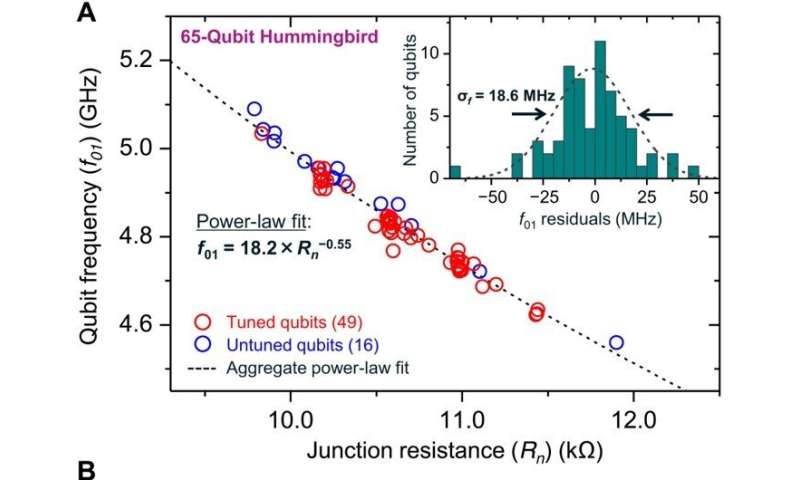
Frequency assignment precision based on statistical aggregates of tuned 27-qubit Falcon and 65-qubit Hummingbird processors. (A) Resistance (Rn) to frequency (f01) correlation for a tuned Hummingbird processor. Cryogenic f01 measurements are plotted against measured junction resistances Rn, with a power-law curve superimposed on the measured data. Both tuned (49 qubits) and untuned (16) qubits are depicted. The inset shows a histogram of residuals with an SD of 18.6 MHz, indicating the practical precision to which we may assign qubit frequencies. (B) The top panel shows statistical precision analysis performed for a total of 241 tuned qubits from a combination of Falcon and Hummingbird chips, with aggregate f01 residuals from individual power-law regressions for each chip. The bottom panel shows identical analysis performed for 117 untuned qubits from both processor families. Cryogenic f01 measurements yield 18.5- and 18.1-MHz spread for tuned and untuned qubits, respectively, indicating that the LASIQ process does not significantly affect the overall spread of qubit frequencies before preparatory chip cleaning, bonding, and cooldown processes. Credit: Science Advances (2022). DOI: 10.1126/sciadv.abi6690 -
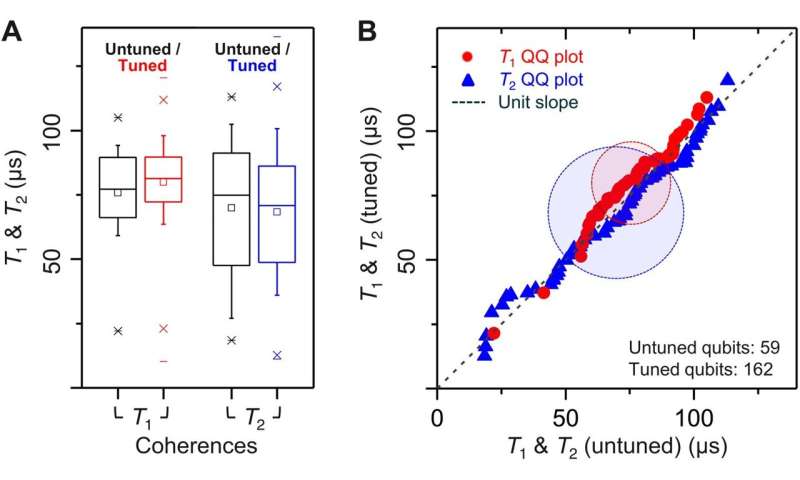
Impact of LASIQ tuning on qubit relaxation (T1, red) and dephasing (T2, blue), using composite (partially tuned) Hummingbird processors. Qubit coherences on four Hummingbird chips are analyzed. On each chip, both untuned and tuned qubits were simultaneously measured, for a total statistical sample of 59 untuned and 162 tuned qubits. (A) Box plots of T1 and T2 distributions (with interquartile box range, 10 to 90% whiskers, 1 to 99% outliers indicated by crosses and minima/maxima by horizontal markers). Coherence distributions show no statistically significant difference in untuned as compared with LASIQ-tuned qubit populations. (B) Illustrates this comparison as a quantile-quantile (QQ) plot of the T1 and T2 distributions. Each point represents a comparison between estimated quantiles from the set of 59 untuned qubits against the interpolated quantiles of the 162 tuned qubits. Good linearity with respect to unit slope indicates a close match of the coherence distributions in tuned and untuned qubit populations. Mean values agree robustly within statistical error bounds. For tuned (untuned) qubits, 〈T1〉 = 80 ± 16 μs (76 ± 15 μs) and 〈T2〉 = 68 ± 25 μs (70 ± 26 μs). The shaded ovals are centered on the mean coherence times and have 1-σ extent in relaxation and dephasing times. Credit: Science Advances (2022). DOI: 10.1126/sciadv.abi6690
Qubit coherence and gate fidelity
In order to determine the effect of laser tuning on qubit coherence (a unique property of a quantum system), the scientists used a composite set of four cooled Hummingbird processors, and increased their coherence. They observed good correspondence, indicating a negligible effect of the LASIQ process on qubit coherence. As a practical demonstration of the tuning capabilities of LASIQ, Zhang et al laser-tuned a 65-qubit Hummingbird processor, operationally cloud-accessible as ibmq_manhattan. They generated the LASIQ tuning plan by avoiding nearest neighbor level degeneracies, while maintaining level separation in the straddling regime. The scientists cooled the 65-qubit processor after LASIQ and measured qubit frequencies with density of frequency detuning between two-qubit gate pairs. The outcomes generated a 100 percent yield of working two-qubit gates, further work will determine the exact collision constraints and identify high-fidelity tuning regimes with progressively increased lattice sizes.
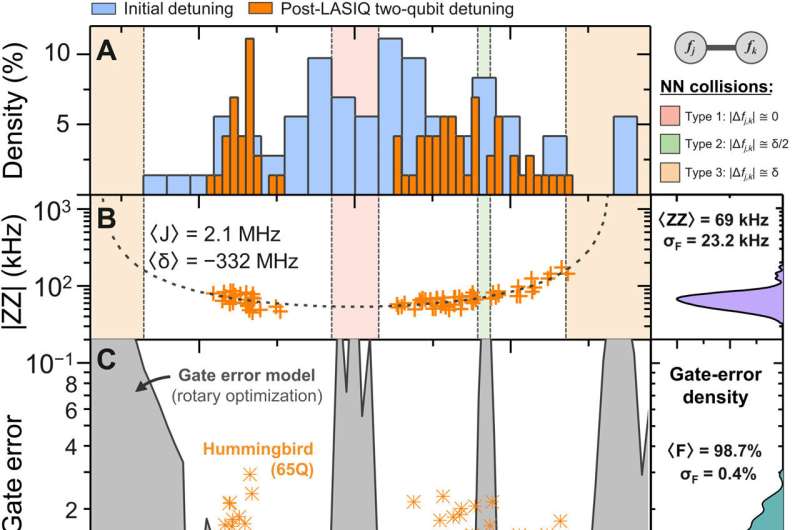
Outlook
In this way, Adam J. Zhang and colleagues, achieved significant yield improvement and high two-qubit gate fidelities for both Falcon and Hummingbird IBM quantum processor types. Based on the outcomes they highlighted the influence of LASIQ—laser annealing of stochastically impaired qubits; an affective post-fabrication frequency tuning method. The method can be applied to multi-qubit processes based on fixed-frequency transmon architectures. The method offers a scalable solution to the problem of frequency crowding, with adaptability to scale qubits in progressively larger quantum processors. Future work will include tuning plans to minimize errors of near-neighbor collisions and spectator collisions for a maximized yield.
More information: Eric J. Zhang et al, High-performance superconducting quantum processors via laser annealing of transmon qubits, Science Advances (2022). DOI: 10.1126/sciadv.abi6690
T. D. Ladd et al, Quantum computers, Nature (2010). DOI: 10.1038/nature08812
Journal information: Science Advances , Nature
© 2022 Science X Network





















